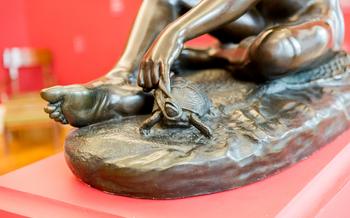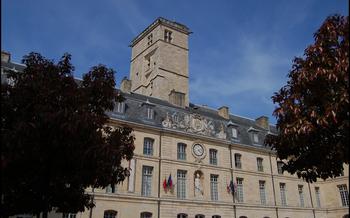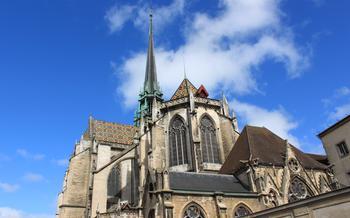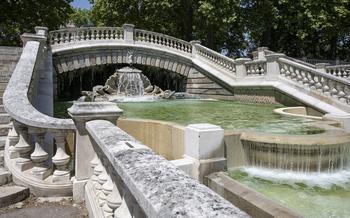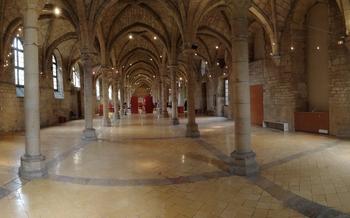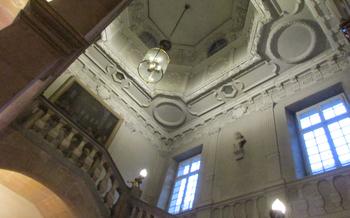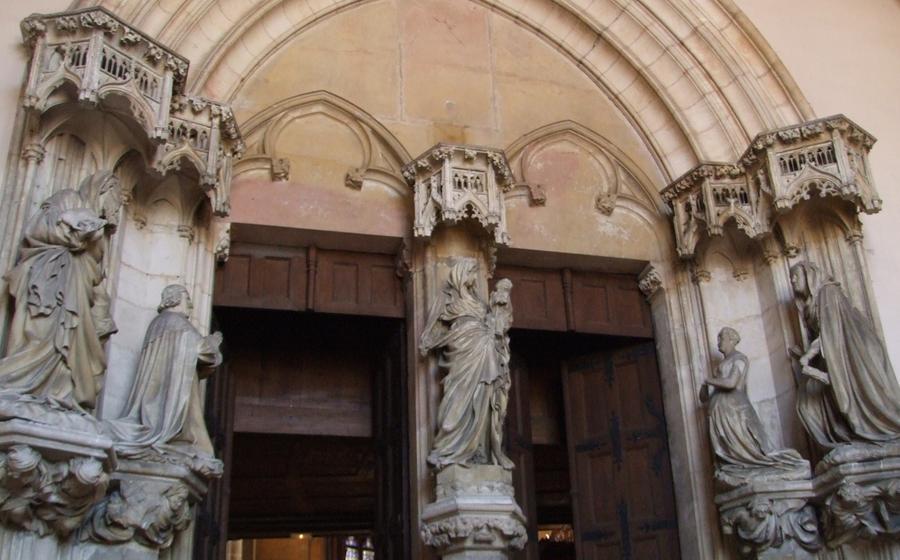
Chartreuse de Champmol
- Chartreuse de Champmol: A Gothic Masterpiece
- The Dukes of Burgundy: Patrons of the Arts
- The Well of Moses: A Sculpted Masterpiece
- The Tomb of Philip the Bold: A Gothic Gem
- The Cloister: A Place of Serenity
- The Chapter House: A Venue for Important Gatherings
- The Refectory: A Place of Community
- The Library: A Treasure Trove of Knowledge
- The Gardens: A Place of Beauty and Tranquility
- Nearby Attractions: What Else to See and Do in Dijon
- The Legend of the Golden Fleece: A Tale of Adventure and Romance
- The Gastronomy of Dijon: A Culinary Delight
- The People of Dijon: Warm and Welcoming
- Insider Tip: Uncovering Hidden Treasures
Chartreuse de Champmol: A Gothic Masterpiece
The Chartreuse de Champmol, a former Carthusian monastery, stands as a testament to the artistic and cultural legacy of Dijon. Founded in 1383 by Philip the Bold, the first Duke of Burgundy, the Chartreuse was designed as a lavish complex that would serve as the ducal family's mausoleum and a place of spiritual retreat for the Carthusian monks. Constructed in the Flamboyant Gothic style, the Chartreuse exhibits exquisite architectural details, intricate interior design, and notable artworks that reflect the wealth and power of the Dukes of Burgundy.
Historical Significance: The Chartreuse de Champmol holds immense historical significance as a symbol of the power and prestige of the Dukes of Burgundy, who ruled over a vast and wealthy territory spanning from the Netherlands to Switzerland. The monastery was a testament to their piety and served as a center of religious and cultural life in Dijon.
Architectural Features: The Chartreuse de Champmol showcases remarkable architectural features that exemplify the Flamboyant Gothic style. Its intricate stone carvings, soaring buttresses, and delicate pinnacles create a sense of grandeur and elegance. The church, with its ribbed vaults and stained-glass windows, is a masterpiece of Gothic architecture.
Interior Design: The interior of the Chartreuse is adorned with stunning frescoes, sculptures, and tapestries that contribute to its rich visual appeal. The vibrant colors and intricate details of these artworks create a sense of awe and spirituality.
Notable Artworks: Among the notable artworks housed within the Chartreuse, the Well of Moses stands out as a masterpiece of Gothic sculpture. Carved by Claus Sluter and his workshop, the well features life-sized figures of Old Testament prophets and saints, showcasing the artist's exceptional skill and attention to detail. Other notable artworks include the tomb of Philip the Bold, a magnificent work of art that encapsulates the artistic achievements of the Burgundian court.
The Dukes of Burgundy: Patrons of the Arts
The construction of the Chartreuse de Champmol was intimately linked to the patronage of the Dukes of Burgundy, a powerful and influential dynasty that ruled over the region during the 14th and 15th centuries. The dukes were passionate patrons of the arts, and their support was instrumental in the creation of this magnificent masterpiece.
Duke Philip the Bold, the founder of the Chartreuse, was a particularly ardent patron of the arts. He commissioned numerous works of art for the monastery, including the renowned Well of Moses and the tomb of his father, John the Good.
Philip's son, Duke John the Fearless, continued his father's legacy of patronage. He commissioned the construction of the chapter house and the refectory, two of the most impressive buildings in the complex. The dukes' patronage extended beyond the Chartreuse de Champmol. They were also responsible for the construction of other important buildings in Dijon, such as the Ducal Palace and the Notre-Dame Cathedral.
Their patronage played a crucial role in shaping the cultural landscape of Dijon, transforming it into a vibrant center of artistic production and innovation. The city's rich artistic heritage, which continues to attract visitors from around the world, is a testament to the enduring legacy of the Dukes of Burgundy.
The Well of Moses: A Sculpted Masterpiece
The Well of Moses is undoubtedly the most iconic artwork at the Chartreuse de Champmol. This monumental sculpture, carved from white limestone, stands in the center of the cloister and is a testament to the genius of Claus Sluter and his workshop.
The well takes its name from the six Old Testament prophets and patriarchs who surround the basin, each holding a scroll with a passage from the Bible. Moses, the central figure, stands at the top of the well, his arms outstretched and his gaze fixed on the heavens.
The Well of Moses is a masterpiece of Gothic sculpture, combining realism and symbolism in a harmonious whole. The figures are depicted with great detail and emotion, their faces expressing a range of human emotions, from piety to wisdom and contemplation. The overall composition of the well is also carefully designed, with the figures arranged in a spiral pattern that draws the viewer's eye upward towards Moses.
The Well of Moses was commissioned by Philip the Bold, Duke of Burgundy, as a monument to himself and his dynasty. It was originally intended to be placed in the center of the nave of the church, but it was later moved to the cloister after the church was destroyed.
The Well of Moses has had a profound influence on the history of art. It was one of the first large-scale sculptures to be carved in the new, naturalistic style that would come to define the Early Renaissance. The well also served as a model for other artists, such as Donatello and Michelangelo, who were inspired by Sluter's innovative approach to sculpture.
The Tomb of Philip the Bold: A Gothic Gem
The tomb of Philip the Bold is one of the most remarkable works of art in the Chartreuse de Champmol. Commissioned by his son, John the Fearless, it was created by the Flemish sculptor Claus Sluter and his workshop between 1389 and 14The tomb is made of alabaster and black marble and features a life-size effigy of the duke, depicted in full armor, lying on a bed of state. The effigy is surrounded by 41 mourning figures, known as pleurants, who represent the duke's family and courtiers.
The pleurants are depicted in a variety of poses, expressing grief and sorrow. Their faces are highly individualized and display a wide range of emotions, from deep sadness to stoic resignation. The pleurants are considered to be among the finest examples of Gothic sculpture and have been praised for their realism and emotional intensity.
The tomb of Philip the Bold is not only a masterpiece of Gothic art but also a significant historical monument. It offers a glimpse into the life and times of one of the most powerful and influential figures in medieval Burgundy. The tomb is also a reminder of the close relationship between the dukes of Burgundy and the Chartreuse de Champmol, which they founded and supported throughout their rule.
The Cloister: A Place of Serenity
In the heart of the Chartreuse de Champmol lies a secluded haven known as the cloister. Surrounded by graceful Gothic arches and intricate carvings, this tranquil space invites visitors to step back in time and experience the serene atmosphere of a medieval monastery.
The cloister served as a place of contemplation and prayer for the Carthusian monks who resided at Champmol. Its elegant arcades provided a sheltered walkway, allowing the monks to seek solace and spiritual reflection in the midst of their busy daily lives.
The cloister garden, with its neatly trimmed lawns, fragrant flowerbeds, and central fountain, symbolized the Garden of Eden and served as a reminder of the monks' connection to the natural world. The garden was also a source of herbs and medicinal plants, which the monks used for healing purposes.
The cloister was not merely a physical space but also a symbolic representation of the monks' inner journey. Its four sides, each with its own unique architectural features, represented the four stages of the monastic life: the novitiate, the profession, the temporary vows, and the solemn vows.
As visitors wander through the cloister, they can imagine the monks pacing thoughtfully beneath the arches, meditating on their faith and seeking guidance from God. The cloister's serene atmosphere and symbolic richness make it a truly special place within the Chartreuse de Champmol.
The Chapter House: A Venue for Important Gatherings
The chapter house was a crucial space within the Chartreuse de Champmol, serving as a venue for significant gatherings and official proceedings. This impressive hall, characterized by its vast dimensions and vaulted ceilings, was designed to accommodate the entire community of monks and hold chapter meetings. During these meetings, important matters pertaining to the monastery's governance, discipline, and spiritual life were discussed and decided upon.
The chapter house also played a vital role in the election of new priors, the heads of the monastic community. These elections were conducted through a solemn and formal process, with the monks casting their votes in a secret ballot. The newly elected prior would then be installed in his office during a special ceremony held in the chapter house.
Furthermore, the chapter house served as a venue for other significant events, such as the reception of distinguished guests and the reading of important documents. It was a place where the monks gathered to receive instructions and guidance from their superiors, fostering a sense of unity and shared purpose within the community.
The Refectory: A Place of Community
The refectory, or dining hall, of the Chartreuse de Champmol is a remarkable example of Gothic architecture and monastic life. Built in the 14th century, it served as a communal dining space for the Carthusian monks who resided at the monastery. The refectory's design and layout reflect the importance of community and shared meals in monastic culture.
The hall is a large, rectangular space with a high vaulted ceiling. Long rows of wooden tables and benches line the sides of the room, where the monks would gather for their daily meals. The refectory's simplicity and lack of ornamentation emphasize its functional purpose as a place for nourishment and fellowship.
Meals in the refectory were a time for the monks to come together, share stories, and strengthen their bonds of community. The act of dining together was seen as a sacred ritual, a way to express their unity and devotion to their faith.
The refectory's architectural features also contribute to its spiritual significance. The high ceiling and large windows create a sense of spaciousness and light, which symbolize the monks' connection to the divine. The stained glass windows depict scenes from the Bible and the lives of the saints, providing visual reminders of the monks' commitment to their religious beliefs.
Today, the refectory stands as a testament to the communal nature of monastic life and the importance of shared meals in the Carthusian tradition. It is a reminder of the deep bonds that were formed between the monks who lived and worked together at the Chartreuse de Champmol.
The Library: A Treasure Trove of Knowledge
The Chartreuse de Champmol also boasted an impressive library, which served as a hub of intellectual activity and learning for the monks. The library's origins can be traced back to the early days of the monastery, when the monks began to collect and copy manuscripts. Over time, the collection grew significantly, encompassing a wide range of subjects, including theology, philosophy, history, and science.
The library's collection was particularly notable for its collection of illuminated manuscripts, which were painstakingly crafted by skilled scribes and artists. These manuscripts were often adorned with intricate illustrations and decorative elements, making them true works of art. The library also housed a number of rare and valuable books, including early editions of classical texts and scientific treatises.
The library played a vital role in the intellectual life of the monastery. The monks used it to study and research, and to prepare their sermons and lectures. The library was also open to visitors, who came to consult its collection and to engage in scholarly discussions with the monks.
In addition to its collection of books and manuscripts, the library also contained a number of other valuable objects, such as globes, maps, and scientific instruments. These objects were used by the monks to teach and to conduct their own research. The library's collection was not only a source of knowledge but also a symbol of the monastery's commitment to learning and scholarship.
The Gardens: A Place of Beauty and Tranquility
The Chartreuse de Champmol is surrounded by beautifully landscaped gardens that offer a tranquil oasis amidst the bustling city. The gardens were designed in the 14th century and have been carefully maintained over the centuries, preserving their original charm and splendor. Visitors can stroll along the winding paths, admiring the vibrant flowerbeds, manicured lawns, and towering trees. The gardens are a popular spot for relaxation and contemplation, providing a serene escape from the urban environment.
The gardens feature a diverse collection of plants and flowers, including roses, lilies, irises, and peonies. The air is filled with the sweet fragrance of blooming flowers, creating a sensory feast for visitors. The gardens are also home to a variety of trees, including oak, maple, and chestnut, which provide shade and shelter from the sun. The rustling of leaves in the breeze adds to the peaceful ambiance of the gardens.
In addition to their aesthetic beauty, the gardens also hold symbolic meaning within the Christian tradition. The garden is often seen as a representation of paradise, a place of peace and harmony where humans can commune with God. The flowers and plants in the garden symbolize the beauty and diversity of creation, while the trees represent strength and stability. The gardens at the Chartreuse de Champmol serve as a reminder of the interconnectedness of nature and spirituality, offering visitors a place to find solace and inspiration.
Nearby Attractions: What Else to See and Do in Dijon
The Chartreuse de Champmol is just one of the many cultural treasures that Dijon has to offer. Visitors who are interested in exploring more of the city's rich history can visit the Musée des Beaux-Arts, which houses a collection of paintings and sculptures from the Middle Ages to the 20th century. The city is also home to several other museums, including the Musée Archéologique, which has a collection of artifacts from the region's prehistoric and Roman past, and the Musée Magnin, which houses a collection of 17th-century Dutch and Flemish paintings.
In addition to its museums, Dijon is also known for its vibrant cultural scene. The city hosts a number of festivals throughout the year, including the Festival International de la Route des Grands Crus, which celebrates the region's wines, and the Dijon Jazz Festival, which features performances by some of the world's top jazz musicians.
Dijon is also a great place to shop, with a wide variety of boutiques and shops selling everything from clothing and accessories to souvenirs and local products. The city is also home to a number of markets, including the Marché aux Puces, which sells antiques and bric-a-brac, and the Marché des Halles, which sells fresh produce and other local products.
For those who are looking for something to eat, Dijon has a wide variety of restaurants to choose from, serving everything from traditional French cuisine to international fare. The city is also known for its Dijon mustard, which is a popular condiment used in many French dishes.
Dijon is also a great base for exploring the surrounding region. The city is located in the heart of the Burgundy wine region, and there are a number of wineries and vineyards in the area that offer tours and tastings. The city is also close to a number of other attractions, including the Château de Fontaine-Française, the Vézelay Abbey, and the Morvan Regional Natural Park.
The Legend of the Golden Fleece: A Tale of Adventure and Romance
The Chartreuse de Champmol is steeped in history and legend, and one of the most captivating tales associated with it is that of the Golden Fleece. This mythical fleece, said to possess magical powers, was the object of a legendary quest undertaken by Jason and the Argonauts in Greek mythology.
According to the legend, the Golden Fleece was guarded by a fearsome dragon and was located in a distant land called Colchis. Jason, a courageous hero, set out on a perilous journey to retrieve the fleece, accompanied by a band of loyal companions. After overcoming numerous obstacles and challenges, including encounters with mythical creatures and treacherous storms, Jason and his crew finally reached Colchis and successfully retrieved the Golden Fleece.
The Dukes of Burgundy, who were patrons of the Chartreuse de Champmol, were fascinated by the legend of the Golden Fleece. They adopted the Golden Fleece as their symbol and incorporated it into their coat of arms, using it to represent their power, wealth, and ambition. The Golden Fleece became a symbol of the dukes' desire to emulate the heroic deeds of Jason and to establish their own legacy as legendary rulers.
The legend of the Golden Fleece continues to captivate imaginations to this day, inspiring countless works of art, literature, and cinema. Its enduring legacy is a testament to the power of myth and adventure, and its connection to the Chartreuse de Champmol adds to the allure and mystique of this historic site.
The Gastronomy of Dijon: A Culinary Delight
Dijon is a paradise for food lovers, offering a delectable array of regional specialties and must-try dishes. One of the city's most famous culinary exports is, of course, Dijon mustard, a staple condiment known worldwide for its tangy and slightly spicy flavor. Made from brown mustard seeds, white wine, and various spices, Dijon mustard is a versatile ingredient that can be used in everything from salad dressings to marinades to sauces.
Beyond mustard, Dijon boasts a rich gastronomic heritage that reflects its Burgundian roots. Bœuf bourguignon, a classic French beef stew cooked in red wine, is a must-try for any visitor to the city. Another local specialty is escargots de Bourgogne, or Burgundy snails, which are typically served with garlic butter and parsley.
Dijon is also renowned for its excellent wines, produced in the nearby Côte d'Or region. The region's vineyards produce a variety of world-class wines, including Pinot Noir, Chardonnay, and Aligoté. Visitors to Dijon can enjoy wine tasting sessions at local wineries or simply savor a glass of wine at one of the city's many charming cafés or restaurants.
For those who love to cook, Dijon's food markets are a treasure trove of local ingredients and culinary delights. The city's largest market, Les Halles Centrales, is a bustling hub of activity where vendors sell fresh produce, cheese, meat, fish, and more. Visitors can also find a variety of specialty food shops in Dijon, where they can purchase local products such as mustard, wine, and cheese.
Dijon's culinary scene is vibrant and diverse, offering something to satisfy every palate. Whether you're a foodie looking to sample the region's specialties or simply a traveler looking for a delicious meal, Dijon is sure to delight your taste buds.
The People of Dijon: Warm and Welcoming
Dijon is renowned for its warm and welcoming people, who take pride in their city and its rich heritage. The locals are known for their friendly and hospitable nature, always willing to lend a helping hand or share a smile with visitors. The sense of community in Dijon is strong, with people actively participating in local events, festivals, and traditions.
Dijon's vibrant social life revolves around its charming streets, lively markets, and cozy cafes. Locals enjoy gathering in public spaces, such as Place de la Libération or Place du Bareuzai, to socialize, sip on a glass of local wine, and engage in lively conversations. Whether you're strolling through the city center or exploring the picturesque neighborhoods, you'll find that the people of Dijon are always ready to greet you with a warm smile and a friendly "bonjour."
To truly immerse yourself in the local culture, take the time to interact with the people of Dijon. Visit the bustling markets, where vendors passionately share their knowledge about regional products, or join a local cooking class to learn the secrets of Burgundian cuisine. Attend one of the many festivals or events that celebrate Dijon's rich history and traditions, such as the International Mustard Festival or the Nuits Saint-Georges wine festival. By engaging with the locals, you'll gain a deeper understanding of their way of life and create lasting memories of your visit to Dijon.
Here are a few tips for interacting with the people of Dijon:
- Greet people with a friendly "bonjour" (good day) or "bonsoir" (good evening), followed by a handshake or a nod.
- Show an interest in their culture and traditions, and be willing to try new things.
- Learn a few basic French phrases to show your respect and willingness to communicate.
- Be patient and understanding, as not everyone may speak English fluently.
- Embrace the local customs and traditions, such as kissing both cheeks when greeting someone you know well.
Insider Tip: Uncovering Hidden Treasures
Beyond the well-known attractions, the Chartreuse de Champmol holds hidden treasures waiting to be discovered. In the library, visitors can request to view special collections, including rare manuscripts and incunabula. The gardens offer secluded corners and hidden paths, inviting visitors to find tranquility and inspiration. Keep an eye out for the small door leading to the monks' former orchard, now a peaceful retreat with ancient fruit trees.
In Dijon, venture off the beaten track to explore hidden gems. Visit the quirky Owl Museum, dedicated to the nocturnal bird of prey. Discover the underground city of Dijon, a labyrinth of tunnels and cellars that once served as a refuge during wartime. Join a guided tour of the city's historic courtyards, each with its own unique charm and stories to tell.
For a truly immersive experience, attend one of Dijon's many festivals and events. The International Mustard Festival celebrates the city's famous condiment with tastings, workshops, and parades. The Nuits Saint-Georges Wine Festival showcases the region's renowned wines with tastings, concerts, and fireworks. Immerse yourself in the vibrant atmosphere and connect with the local community.
Uncovering these hidden treasures will provide a deeper understanding and appreciation of Dijon's rich history, culture, and gastronomy. Embrace the opportunity to go beyond the surface and create lasting memories in this captivating city.
